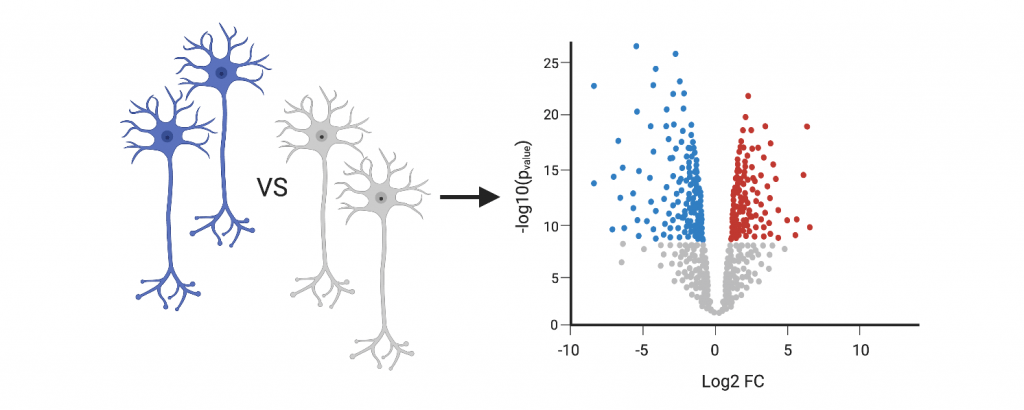Alzheimer’s disease (AD) is a complex and heterogenous condition in which multiple molecular pathways are disrupted in different cell-types and lead to disease. Genetic findings indicate that amyloid-beta protein clearance and degradation pathways, cholesterol metabolism and the immune system are associated with AD etiology. However, the specific mechanism, genes and molecular networks have not yet been completely identified. Single-nuclei transcriptomic (snRNA-seq) data from human brains provides a detailed molecular atlas to study the pathways dysregulated in AD. We propose to deepen our understanding of the genes, network and molecular pathways associated with AD by sequencing a high-number of neuronal and glial cells (approximately 3.3 million cells) from human brain carriers of key genetic mutations and high risk variants, non-carrier sporadic AD cases and neuropath-free controls. We will leverage a unique collection of human tissue from the Dominantly Inherited Alzheimer Network and Knight-ADRC brain banks, and select +220 brains to perform systematic cell- type specific transcriptomic analyses. This is a unique and innovative study designed to analyze cell-specific transcriptomic dysregulation in carriers of high effect risk variants (TREM2 and APOE) and fully penetrant pathogenic mutations in APP/PSEN1/PSEN2 and by comparing them to sporadic AD cases and neuropath-free controls. This is a powerful approach to address disease heterogeneity, and will provide highly informative insights into the biology and pathology of neurodegeneration. Replication of these findings will be performed in snRNA-seq data from induced pluripotent stem cell derived neurons, astrocytes, and microglia-like cells that will be genome edited to add/remove genetic variants, as well as datasets that are being publicly released. Finally, we will create a knowledge portal in which all of the processed snRNA-seq data from our study will be harmonized with that of other research groups to provide a comprehensive molecular atlas that will provide additional insights into the biology and pathology of AD for the entire research community.

Cerebrovascular pathology is present throughout stages of Alzheimer’s Disease and is correlated with cognitive changes. There is strong evidence that vascular dysfunction is a significant driver of neuropathology. Our long- term objective is to understand the function of Alzheimer’s Disease-associated risk genes in vascular cells, their contribution to the development of cerebrovascular pathology and the opportunities to use this information in therapeutic development. There are over 27 Alzheimer’s Disease-associated risk (AD-risk) loci encompassing numerous genetic variants in non-coding and coding regions and hundreds of linked genes. Our overarching hypothesis is that a subset of AD-risk genes impairs vascular function, causing release of inflammatory factors, blood brain barrier (BBB) impairment, and reduced perfusion, thus contributing to neurodegeneration. To address this, we have assembled a multi-disciplinary team with a proven track record of collaboration, including with ADSP and ADGP members, who bring expertise in vascular pathology in dementia, endothelial cell (EC) signaling and EC functional testing, Alzheimer’s Disease genomics, single cell and nuclear transcriptomics, bioinformatics, CRISPR-based gene editing for large scale screening and AD mouse models for in-depth functional assessment in vivo. Notably, we will address differences in gene effects related to the important biological variables, sex and metabolic disease. Men and women differ in their genetic risk for Alzheimer’s Disease, with sex-specific polygenic risk scores providing better prediction of onset, progression, and pathology than pooled-sex scores. Over 80% of individuals with Alzheimer’s Disease have co-morbid metabolic disease, which exacerbates vascular pathology. We have identified the top 50 AD-risk SNPs and 600 AD-associated genes, and these will be targeted for induced pluripotent stem cell (iPSC)-derived endothelial cell (EC) screens by prime editing and CRISPR-based gene inhibition and activation approaches respectively. iPSC-based production of human ECs and mural cells in 2D and 3D models has been optimized and scaled to enable efficient functional testing of the impact of gene changes, including on neuro-vascular interactions in cerebral organoids. Discoveries made in these human cell systems will be validated by an in-depth investigation of gene expression changes in individual ECs and mural cells across a large collection of Alzheimer’s Disease brain samples using single nuclear sequencing. The EC translatome will also be obtained from mouse Alzheimer’s Disease models that incorporate sex and metabolic disease. These diverse datasets will be harmonized and integrated in order to map vascular phenotypes of AD-risk genes and identify critical molecular pathways that are targetable drivers of AD cerebrovascular pathology. These data will add to the breadth of knowledge being gathered by other groups to further elucidate underlying neuronal, glial, microglial, endothelial and mural cell-cell interactions that contribute in a substantial way to the complex architecture of Alzheimer Disease pathology.
Representative Papers:
Meningeal lymphatics affect microglia responses and anti-Aβ immunotherapy